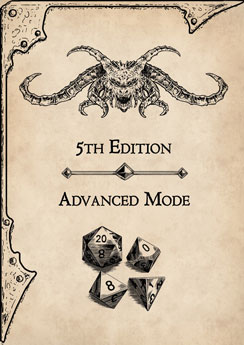Large beast (dinosaur), unaligned
Armor Class 13 (natural armor)
Hit Points 45 (6d10 + 12)
Speed 60 ft.
Proficiency Bonus +2
Proficiency Bonus +3 (5th Edition Advanced Mode)
| STR | DEX | CON | INT | WIS | CHA |
|---|---|---|---|---|---|
| 20 (+5) | 16 (+3) | 14 (+2) | 2 (-4) | 12 (+1) | 6 (-2) |
Saving Throws Str +7
Skills perception +3
Senses passive Perception 13
Languages –
Challenge Challenge 2 (450 XP)
Dash. The struthiomimus can use a bonus action to double its speed for one round.
Keen Sight. The struthiomimus has advantage on Wisdom (Perception) checks that rely on sight.
Pack Tactics. The struthiomimus has advantage on attack rolls against a creature if at least one of its allies is within 5 feet of the creature and the ally isn’t incapacitated.
ACTIONS
- Claw. Melee Weapon Attack: +8 to hit, reach 5 ft., one target. Hit: 11 (1d10 + 5) slashing damage.
- Beak. Melee Weapon Attack: +8 to hit, reach 5 ft., one target. Hit: 8 (1d6 + 5) piercing damage.
5th Edition Advanced Mode
Limiting the power of a character and making the overall difficulty of the game harder, does not reduce the creativity, indeed it does quite the opposite.
The Game Master has the option to use any and all of the instances proposed in this guide, or just some of them according to their preference.
It is the lack of something that move and motivate characters, not the abundance of it
Struthiomimus
Struthiomimus is a large, bipedal, ostrich-like dinosaur that roams the plains and forests of North America. It is one of the fastest and most agile creatures in the land, capable of outrunning most predators and prey. It has a small head with a toothless beak, a long neck, and a long tail. It has three fingers on each hand and four toes on each foot, with the first toe being reduced. It may have feathers, like some other theropod dinosaurs.
DESCRIPTION
Struthiomimus is a member of the ornithomimid family, a group of dinosaurs that evolved to resemble modern birds. Its name means “ostrich mimic”, because it has a similar body shape and long legs that allow it to run fast. It is one of the largest and most common ornithomimids, reaching up to 4.3 meters (14 feet) in length and weighing up to 150 kilograms (330 pounds). It has a small head with a toothless beak, a long neck, and a long tail. It has three fingers on each hand and four toes on each foot, with the first toe being reduced. It is unclear what it ate, but some scientists think it was an omnivore that could feed on plants, eggs, insects, and small animals. It may have used its claws to dig up food or defend itself from predators. It is also possible that it had feathers, like some other theropod dinosaurs.
COMBAT
Struthiomimus is not a very aggressive creature, preferring to avoid confrontation and flee from danger. However, if cornered or threatened, it can use its speed and agility to evade or outrun its enemies. It can also use its claws and beak to slash and peck at its foes, inflicting moderate damage. It may also cooperate with other struthiomimuses or similar creatures, using pack tactics to gain an advantage over larger or stronger opponents. Struthiomimus has a keen sight, which gives it a good perception of its surroundings. It can also dash as a bonus action, doubling its speed for one round.
HABITAT / SOCIETY
Struthiomimus lives in a variety of habitats, such as coastal plains, forests, and swamps. It is a social animal, often traveling in groups or flocks of its own kind or other ornithomimids. It communicates with vocalizations, body language, and feather displays. It may also form alliances or rivalries with other creatures, depending on the situation. Struthiomimus is a curious and intelligent creature, capable of learning from its experiences and adapting to new environments. It may also exhibit some degree of playfulness or mischief, especially when interacting with other creatures.
ECOLOGY
Struthiomimus plays an important role in the ecosystem, as both a consumer and a prey. As an omnivore, it feeds on a variety of plants and animals, helping to regulate the population and diversity of its food sources. It also provides food for larger predators, such as tyrannosaurus, triceratops, ankylosaurus, and edmontosaurus. It may also scavenge on carcasses or leftovers, helping to recycle nutrients and organic matter. Struthiomimus may also disperse seeds or spores through its feces, aiding in the propagation of plants and fungi. Struthiomimus coexists with other dinosaurs, as well as mammals, reptiles, amphibians, birds, and insects, forming a complex and dynamic web of life.
